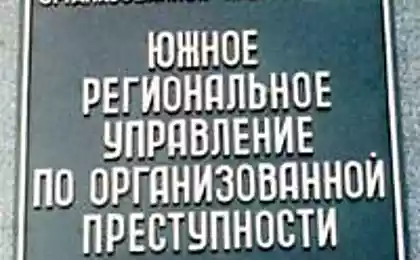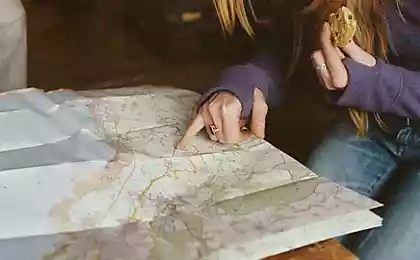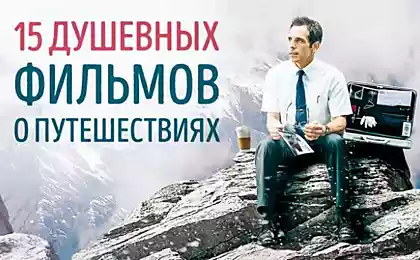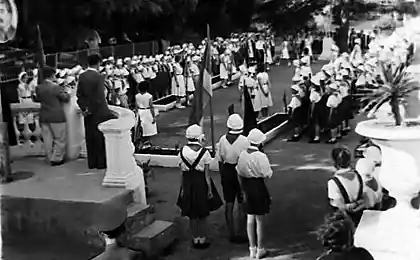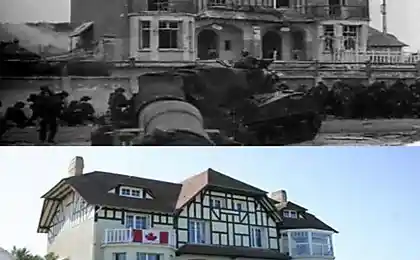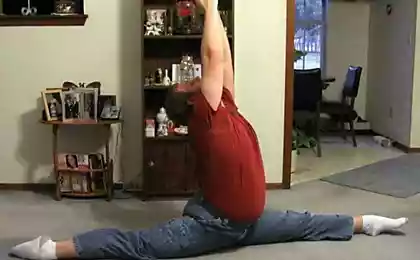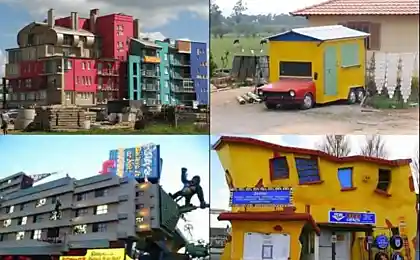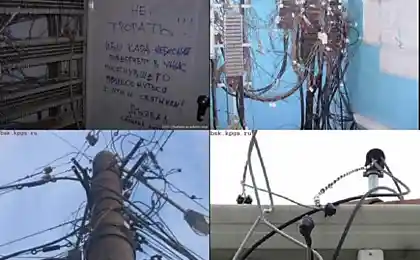1313
Travel to Zakazvkaze - 2013
Our last theme:
To the Pacific Ocean Bike - 2012
Eurotrip on a motorcycle or the seven seas - 2011
From traveling in 2012 we brought her son, so motoputeshestviyakh temporarily suspended.
And we went to the car initially in Stavropol and in Batumi.
And what happened - read below.
Author: Irinka
Background:
There were seven countries: Russia, Georgia, Armenia, Nagorno-Karabakh, Turkey, Azerbaijan, KazahstanVideli 2 Sea: Black and KaspiyskoeVideli Mount Ararat and Lake SevanProbeg: 10 000 kmPoezdka of this year has largely been for us "first." Firstly, the first time we went by car. And secondly, for the first time we are traveling with a child - our 4 month old son. Therefore, our luggage for the most part consisted of strollers, playpen, diapers, rattles, and other much-needed baby items.
Source
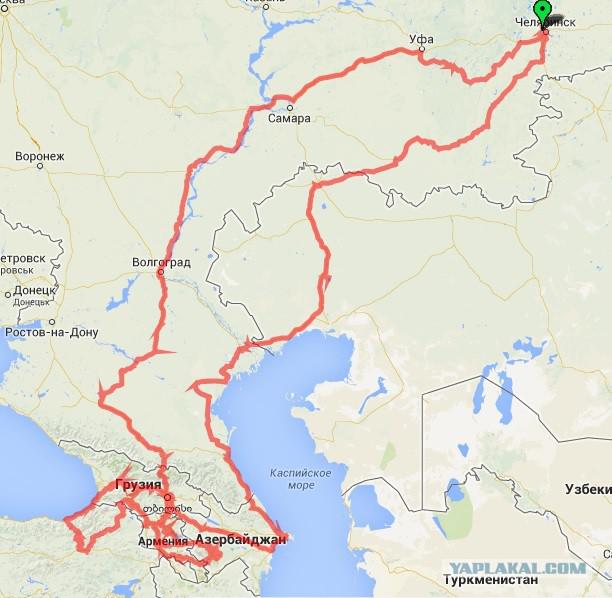
26.08.2013-29.08.2013
The first destination was the Stavropol, where he lived Maxim grandfather - Seryozhin dad.
From the first kilometers we realized that the speed of movement of the car with the baby is much lower than the two of us on a motorcycle. In addition, the first day we decided not to go through Simsk pass to avoid the wagons, and went through Beloretsk. As a result, the first day we were not even in Ufa.
From Ufa to Volgograd went already familiar from past road trip. And then, having passed Elista, in the afternoon of the 4th day of the roads were in Stavropol.

29.08.2013-01.09.2013
4 days rest in Stavropol - walked around the city, sightseeing, as well as a local botanical garden. However, in the middle of the holiday Sergei "word" intestinal infection and was hospitalized for five days. However, it is not particularly spoil the holiday, because on the second day he escaped and went on vacation.
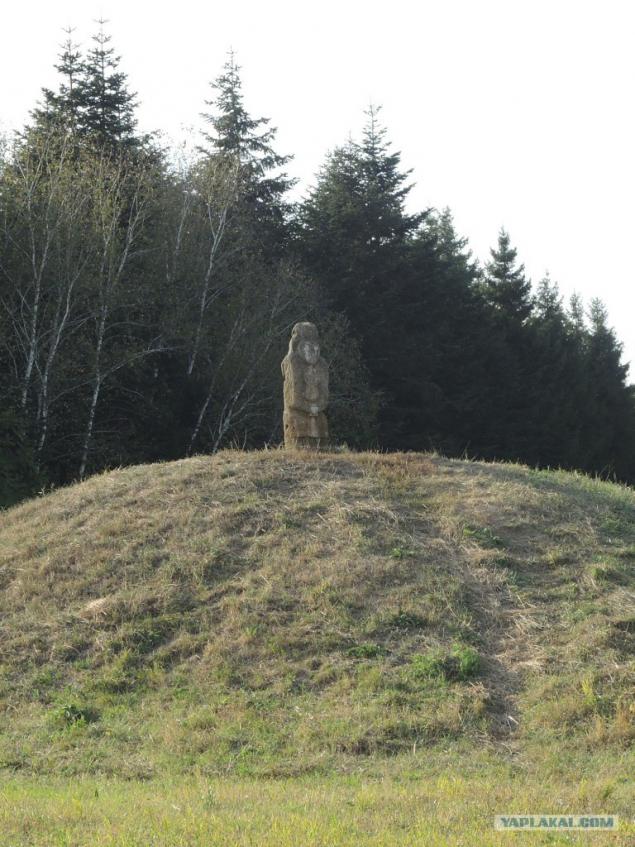
Stavropol - a beautiful city, with the remains of the medieval castle in the center. The unusual climate here - very warm, but the wind blows constantly.
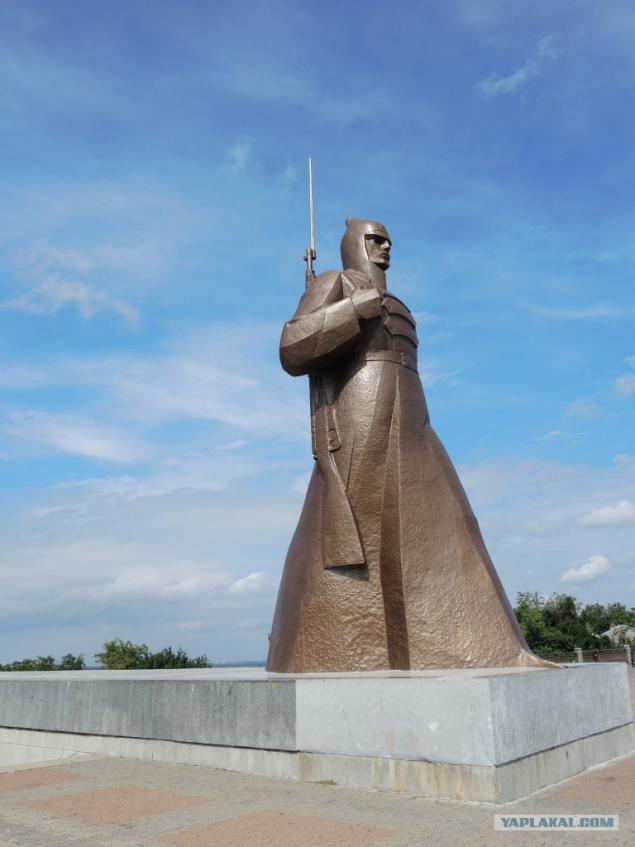
02.09.2013
At the beginning of the day slowly gathered, said goodbye to Sergei's dad and moved to the border with Georgia. Our way lay through the already familiar from previous visits land of Kabardino-Balkaria. By the evening reached Vladikavkaz, capital of North Ossetia. All day along the roads stretched endless fields planted with cereals, corn, apples, grapes and peaches.

The path also struck a significant difference between the cars registered in North and South Ossetia. Severoosetiny live strikingly poorer than the residents of South Ossetia, where neither car - the road jeep. Rumor has it that so hands separated the money allocated for the restoration of South Ossetia.
By nightfall we arrived in Vladikavkaz. With hotels there is the problem - there are some very expensive hotels with mediocre service. Finally, we choose a student residence, where for a small room with a toilet and cockroaches we had been 1,000 rubles.
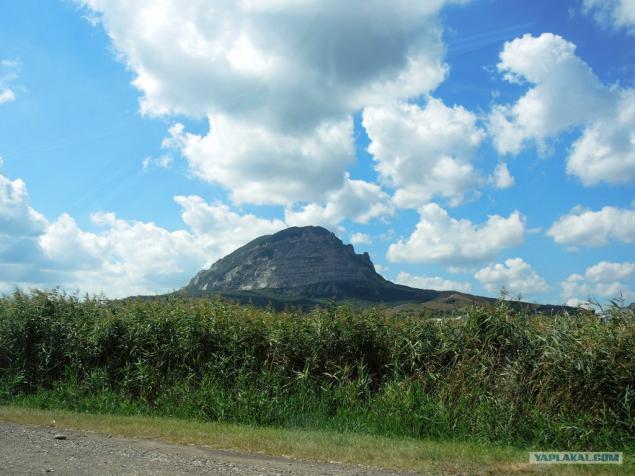
But for dinner bought 2 of these, wonderfully delicious Ossetian pie - with meat and cheese. And where they still try, if not in the capital of North Ossetia?
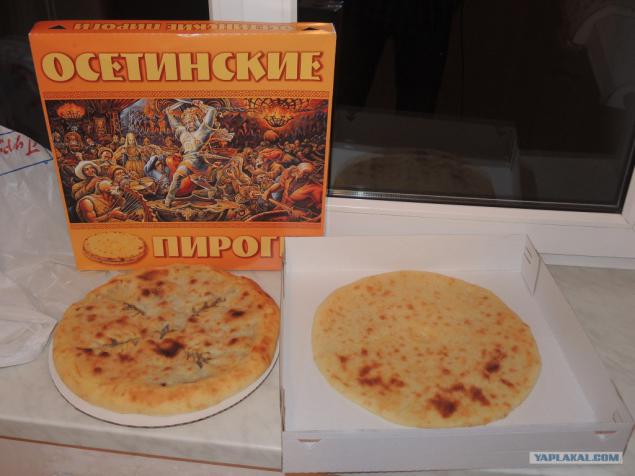
03.09.2013
In the morning tour of Vladikavkaz. Very beautiful waterfront, magnificent monuments on the background of mountains and next to the magnificent cast park, lift and all traces of neglect and lack of tourists, which in good years must have been quite a few.
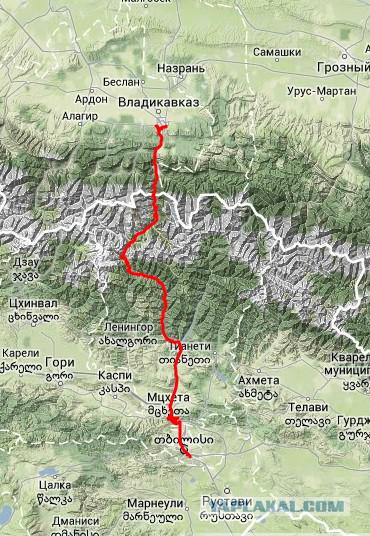
In the morning the weather we do not spoiled - low clouds, the sun was barely peeking out from behind the clouds, drizzling light rain, close to the border with Georgia transferred from the downpour. From Vladikavkaz to the border with Georgia at hand, though I had to go very slowly - a small streamers and slippery from the rain slows down the movement of the road.
The very easily passed the border - the baby in the car works wonders: is smiling staff who have passed almost without examination, after passing through passport control.
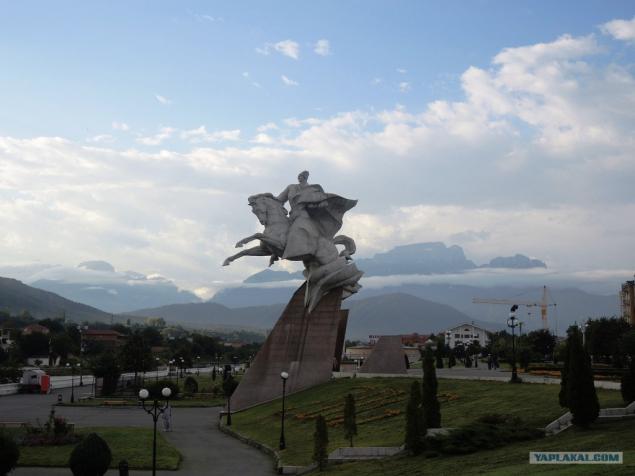
Georgia welcomed us with rain and cool weather. Near the border is Mount Kazbegi, which we unfortunately did not see because of the bad weather and low cloud. But it was possible to drive up close to a small temple of the first half of the millennium at the top of a small mountain at the foot of Kazbegi.
Along the way there are watchtowers, where residents hid impurity during the war and civil strife.
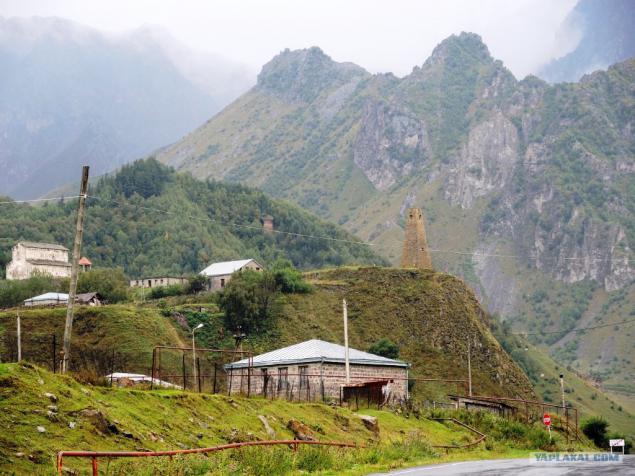
Then we waited for the Cross Pass and the Georgian Military Road. Despite the fact that we had been threatened with terrible stories about the pass, there is no cover on it, it did not seem to us so frightening. Yes and without coverage it was only a small area. On the descent was a difficult time for the baby, the road descended to 900 meters in height, for the first 11 kilometers. Such elevation changes, of course, let's not easy, and occasionally we had to make a stop, so that the pressure we and the child returned to normal.

The first major stop was planned at 70 km from Tbilisi, near the fortress Ananuri. This powerful fortress of 16-18 century, towering over the Aragvi, served as the main reference point for the then formidable rulers of this land.
Since the child was asleep, I visited the fortress, leaving him in the car with the windows ajar. The fortress itself is not large, and the main advantage of the castle - its preservation. The castle remained the full perimeter of the walls, two large towers and several smaller ones. Round Tower now stands without overlap, and at the square preserved floors and stairs. On the tower you can climb to the top.

Although the castle belongs to the 16-18 centuries, one of the towers dates back to the 13th century. From a historical point of view, the most interesting in Ananuri - it's Assumption Church. It was built in 1689 and is a rare case of the temple, postroennoo in the XVII century. These all over the country two or three. Temple classic, dome, on the west side - carved decorations: the cross and grapes. To the west of the Assumption is another temple, which is sometimes called Spassky, sometimes - Church of Our Lady. He's a little older. Time of construction is not known exactly - the late XVI or early XVII. Now it does not work inside is not renovated. Interestingly unless tombstone "mdivanbega Edisher."
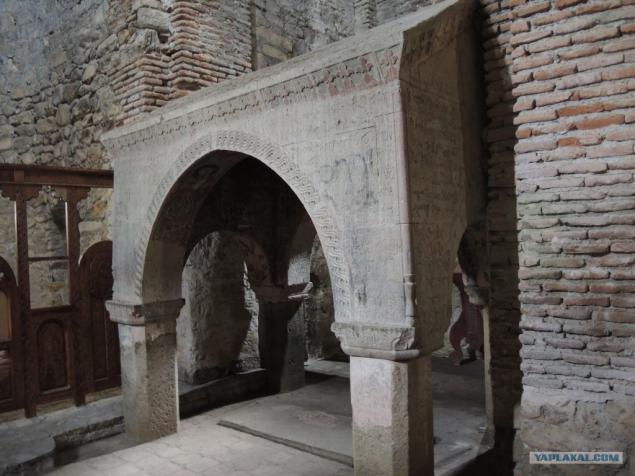
Along the castle-fortress down a narrow lane leading to the reservoir, where you can find some more mysterious ruins. From their low perimeter walls there was nothing left. But the temple was - already in a dilapidated state. Now there is only a single cow grazing.
After strolling along the shore, went further in the direction of Tbilisi.
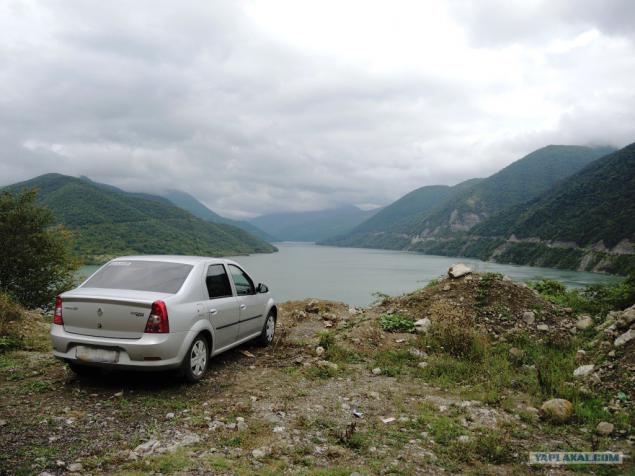
On the way we visited Jvari monastery of the 12th century. Jvari is one of the architectural masterpieces of perfection of architectural forms and is the first in Georgia World Heritage. Its special feature is that it seems to continue the mountain towering over her. From the very same monastery offers stunning views of the valley and the confluence of the rivers. Find the monastery is not difficult - as all the historical monuments of Georgia, lead to it special brown signs, which are found all the way from the road to the monument of architecture. The same indicators we later met in Armenia and Nagorno-Karabakh.
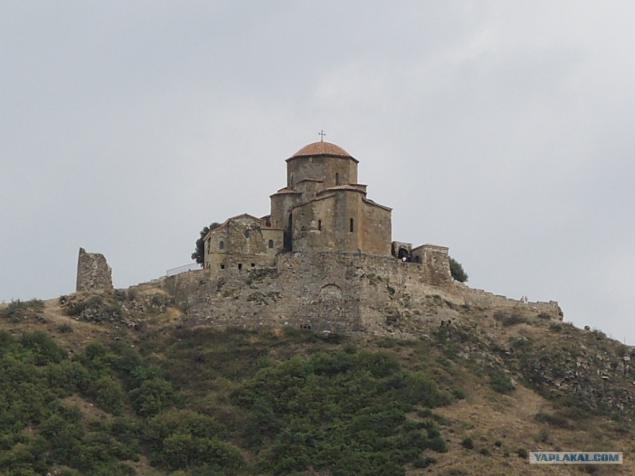
Examine Jvari, descended from the mountain, and came to Mtskheta - the old capital of Georgia, located just a few kilometers north of Tbilisi. Out of interest here for ourselves, we noted Svetitskhoveli - patriarchal cathedral church of the Georgian Orthodox Church, which for millennia was the main cathedral throughout Georgia. Listed among the World Heritage sites. It is now considered one of the spiritual symbols of modern Georgia.
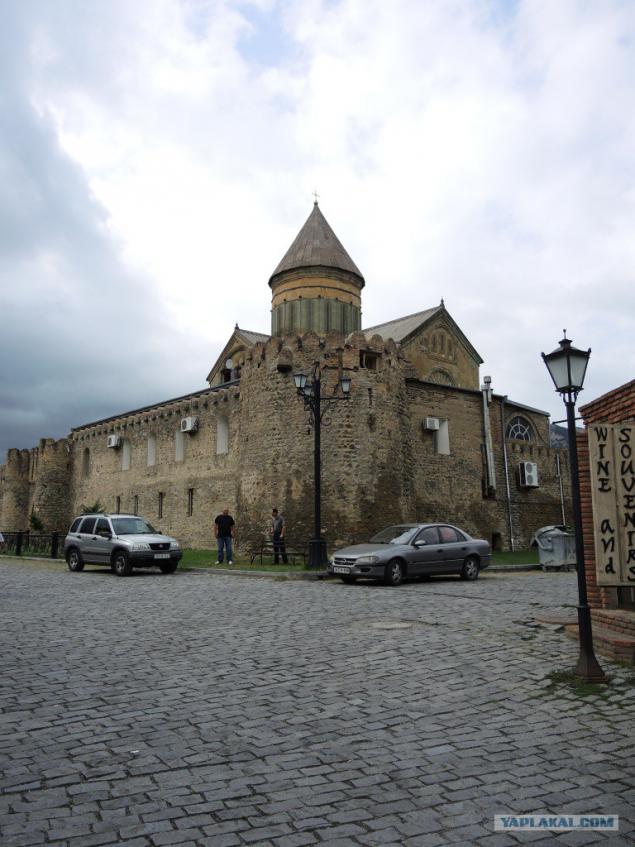
In addition, in the historic part of the city there is a large number of shops with wine. However, taking the wine out there, we would not recommend - unreasonably high price tags based on tourists here combined with the very mediocre quality. Wine in Georgia is better to take away from the tourist areas.
Finally, twist a little Mtskheta, went to Tbilisi. The remaining few kilometers to the capital of Georgia, passed at the present motorway, which runs from Mtskheta, Gori, and continues to build toward Kutaisi.

Tbilisi itself is divided into two parts - the old Tbilisi historical buildings, and a new high-rise buildings with Tbilisi. As dusk, we, first of all, had to decide overnight. In the center of the historic part of the hotel to pick up is not a problem. However, many of them are located in the buildings of 17-18 century, is considered "new buildings". Accommodations can be found here for every taste - from an improvised hostel in a private house, where a few dozen chests you can pick up a clean spacious room with no doors and parking for the car, to the luxurious rooms at the hotel. After seeing a couple of options, we stopped at a hotel room in the center, which cost us $ 60 per night for three. At the same time, and the price includes breakfast and the room had air conditioning, shower, mini bar and TV and Internet.
Before nightfall we had a little walk around the city center, leaving sightseeing the next day. We had dinner here in the heart of the city, in one of the restaurants on the busy street. In the coming days, our diet composition of different barbecues, khachapuri, khinkali and other national dishes. It is worth noting the fact that the prices even in the very center of the city are very reasonable. So, dinner for two with barbecue cost us less than 50 GEL. However, if the institution receives dollars, it is better to take this opportunity to save money - because the amount to be paid in dollars when converted into rubles goes lower than that obtained when converted into rubles at the amount of GEL.
We went to sleep that day is closer to midnight.
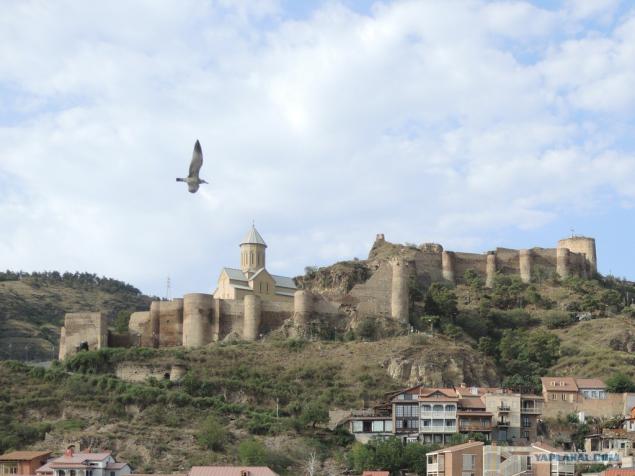
04.09.2013
The whole day spent exploring the city, going to the stroller right after breakfast.
The windows of our rooms overlook the church of St. Virgin Mary, with the equestrian statue of David the Builder in the territory of the church. From the church clearly visible the historical part of the city.

Going down to the river, marched through the streets to the Sioni Cathedral of the same name, in which there are many ancient graves. We were lucky to get to the morning service.

We then briefly left the historic part of town, across the river on the new bridge in the park. Park called us with mixed feelings - in the heart of the historic city is located a new park with several seating areas, each of which is decorated in its own style. There contemporary design of glass and concrete, which looks quite strange on the background of the historic building. Everywhere the green, lots of flowers, neatly trimmed bushes, lawns and around the park paved walking paths. Just above the Park is the residence of the president.
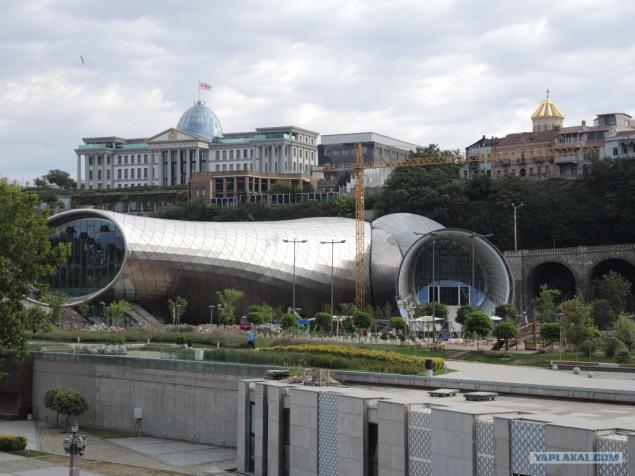
Going round the park, on the same bridge back into the historical part of the city, and went to the basilica Anchiskhati. Anchiskhati, or the Church of the Nativity of the Virgin Mary, is the oldest of the surviving churches in Tbilisi, which dates back to the VI century. Unfortunately, it is very poorly preserved, but still operates.
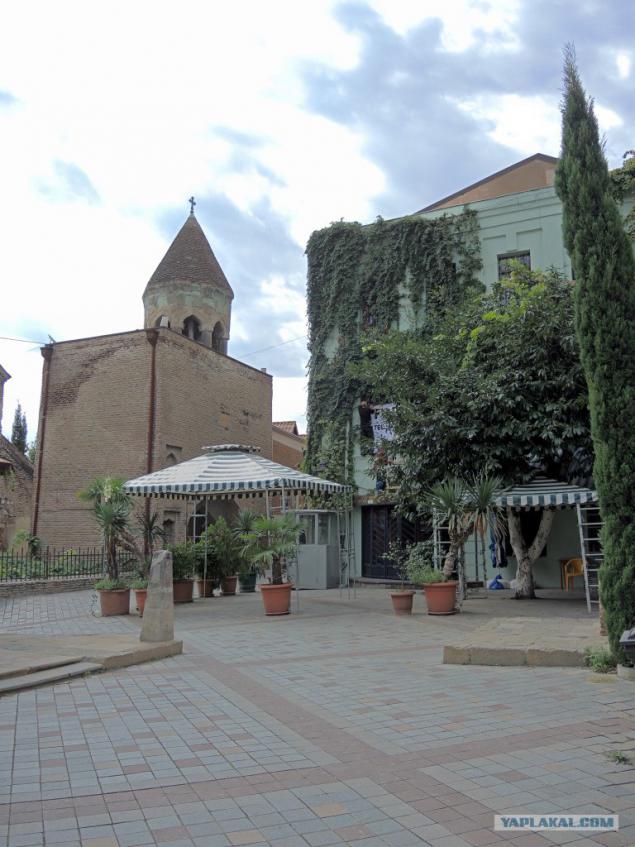
Near Anchiskhati is a modern and very unusual building Rezo Gabriadze puppet theater. It is as if the collected set of large cubes on each other.
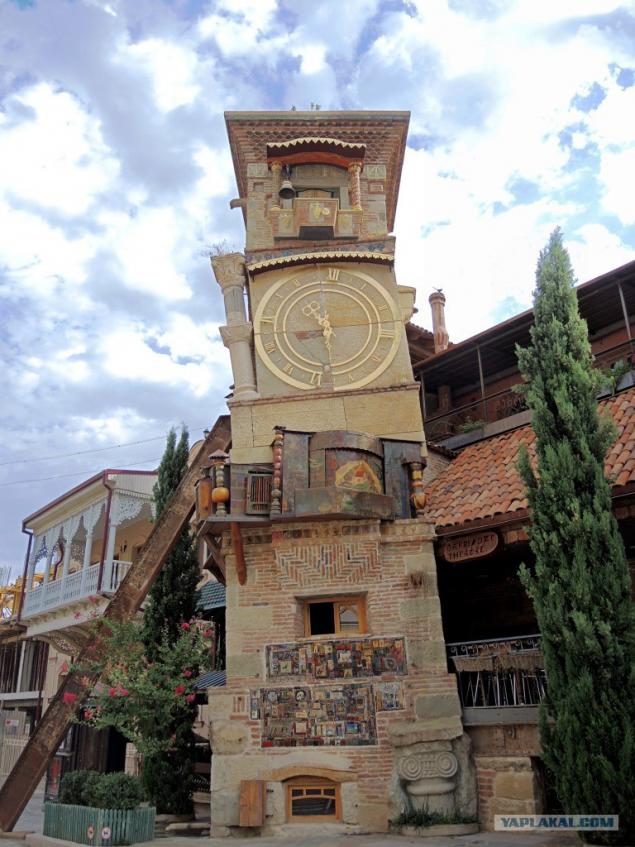
Here we left the old town, and along the fortress walls went on Rustaveli Avenue, which originates from the Freedom Square. In the center stands a column with the monument of St. George Zurab Tsereteli.
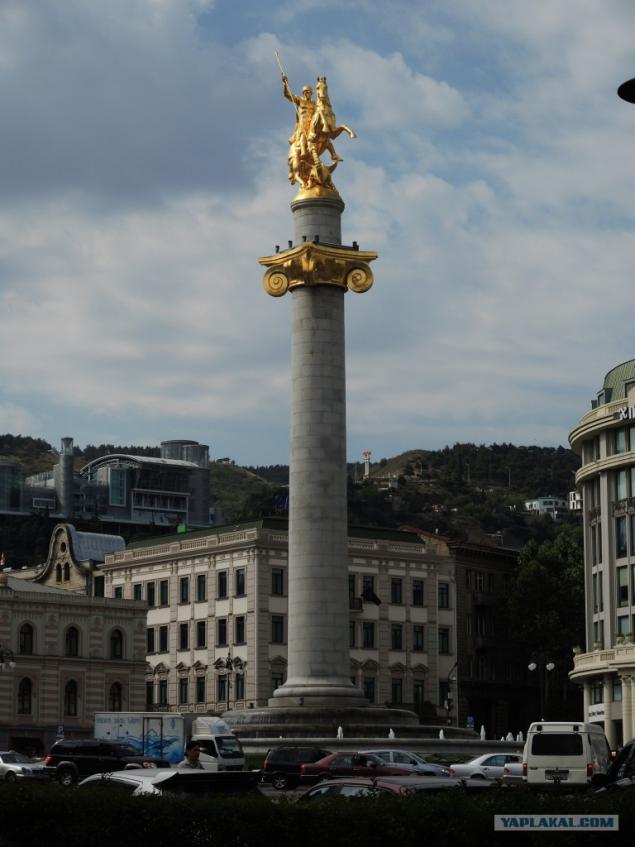
On the avenue, in addition to administrative buildings and even a church the early 20th century (Kashveti) is the National Museum of Georgia. Among other exhibits, our attention exposition dedicated to the occupation of Georgia by Soviet troops. However, there is not anything outstanding represented: wagon freight car, the doors of the bullpen, some photos and excerpts from personal letters to residents of that period. Strange looking messages that the oppressed Russian Georgians, led by the Georgian Stalin.
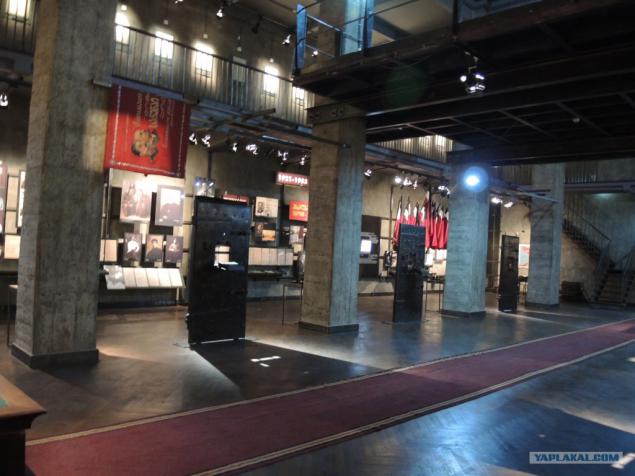
Turning off the avenue near the building of the Foreign Ministry, they climbed the mountain, which is located at the top of the TV tower and a children's park. Park is a funicular that connects the city center to the upper park on Mount Mtatsminda. Average stop half way to the park, located at the pantheon of public figures and poets, where we do not really gone.
Park on the mountain, as well as square, where we walked in the morning, very green and well maintained. A large number of attractions attract crowds of children, although for a walk with a stroller there is not very convenient because of the large number of steps and climbs and descents. By the time we got to the park, the air is warmed so that the child has been stripped to the diaper, and we ourselves have escaped the cold Borjomi. Therefore it was decided to arrange a siesta and return to the hotel.

Later in the afternoon went back to the city, this time we went to the fortress Narikala, which is located on another part of Mtatsminda. It led her cableway begins almost from our hotel. Tickets can be purchased in one or both ends. The first option is even better because of the fortress there is a short descent directly into the old part of town. However, we have learned about this later.
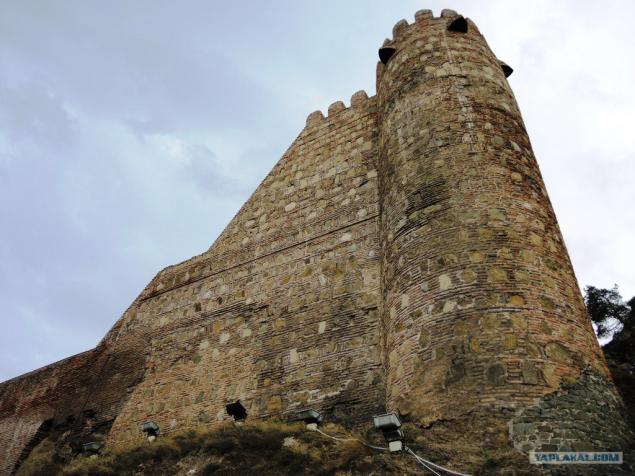
With wheelchair in the cabin of the cable car up, we had no difficulty. Here, at the top is a statue of Mother Georgia (Kartli Mother), erected in 1958. Near Narikala and Tbilisi Botanical Garden is located. On top of Narikala us caught in the rain, gradually developed into a hailstorm. Run up the stairs with a stroller in the rain - that still pleasure.
Back we went by cable car, and went to the old part of the city in search of the restaurant to have dinner. Continuing rain has given us dinner on the terrace of the restaurant (had to go to the premises of the restaurant) and we returned to the room to his knees wet.
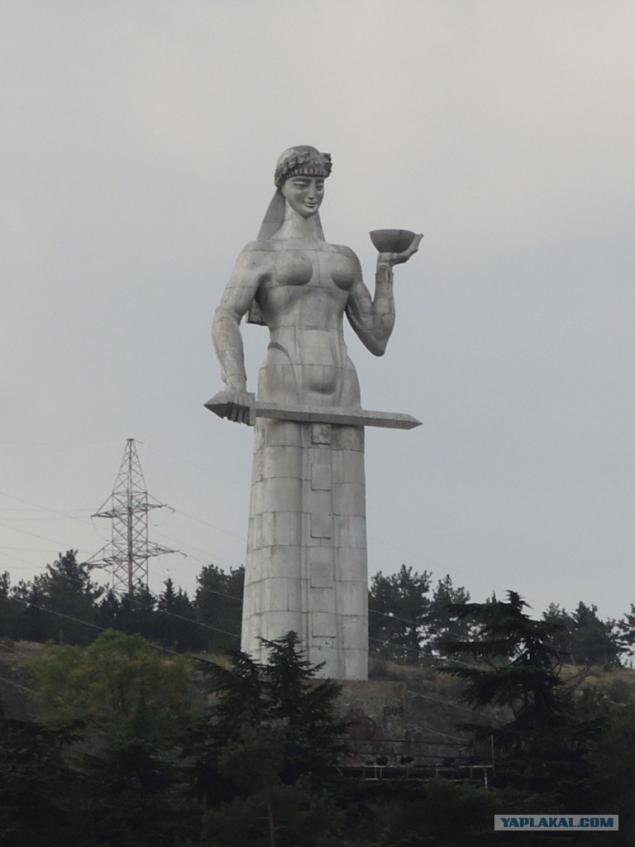
05.09.2013
Despite the fact that in Georgia we had planned a lot more interesting, we decided to go to Armenia, as Georgia came the rain.
Crossed the border is relatively easy, however, had to pay a little more than 3,000 rubles. for various fees and insurance. As well as on the border with Georgia, the border guards are very friendly, and when he saw the child in the car passed inspection of the machine and put a mark in the passport are not asking us to leave the car.
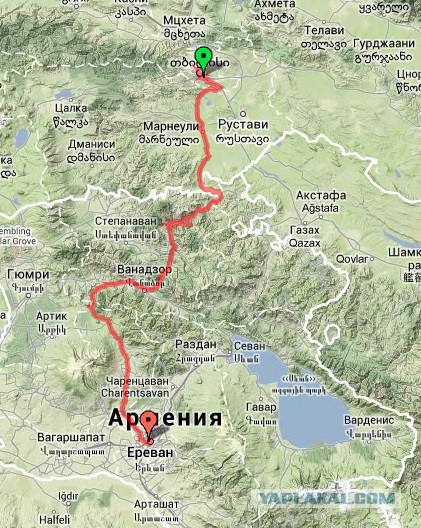
Central Cathedral Guzii
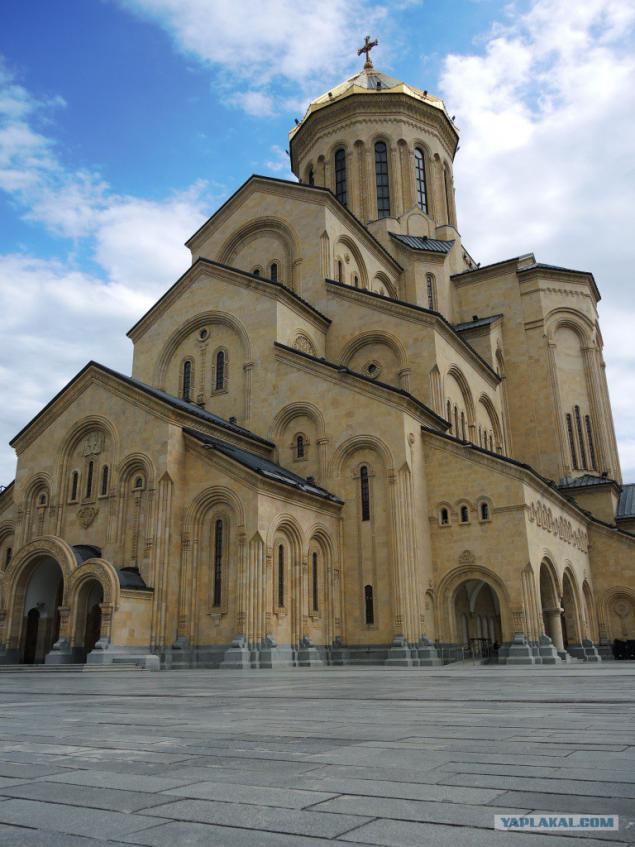
Armenia itself impressed very poor and abandoned the country where ubiquitous destroyed the legacy of Soviet times - abandoned factories, dilapidated shops and factories. But at the same time, people are very friendly and open.

Almost immediately after crossing the border turned off the highway and drove a few kilometers to the first attractions in Armenia - Haghpat acting monastery in the same village Haghpat in northern Armenia, 10 km from the town of Alaverdi. The monastery is situated on a small plateau, the plateau surrounded by canyons. One gets the strange feeling: two villages in the Highlands one another down in the gorge. As the crow flies between several hundred meters, and to travel from one to the other, will have to drive a few tens of kilometers along a winding serpentine. When you go through the gorge, you see around the mountain, up the hill - it is expected that at the top we will see the next valley and the view for kilometers around, but very surprised when the top is a city with a 10-storied buildings and in general it is not the top, and plain.
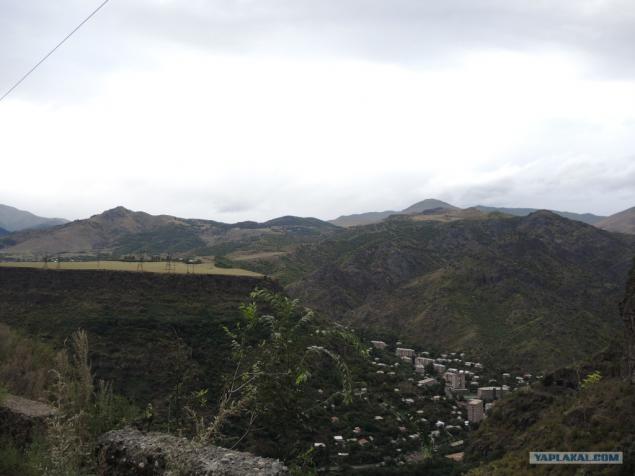
Himself Haghpat was founded at the end of the 1st millennium. The complex is very well preserved. We visited several churches, refectory, porch and tomb. Strange and a little frightening feature is the custom to bury the dead right in the floor of the church and along the walls of the monastery, which is why often the path between the buildings and in the premises of passes on ancient tombstones.
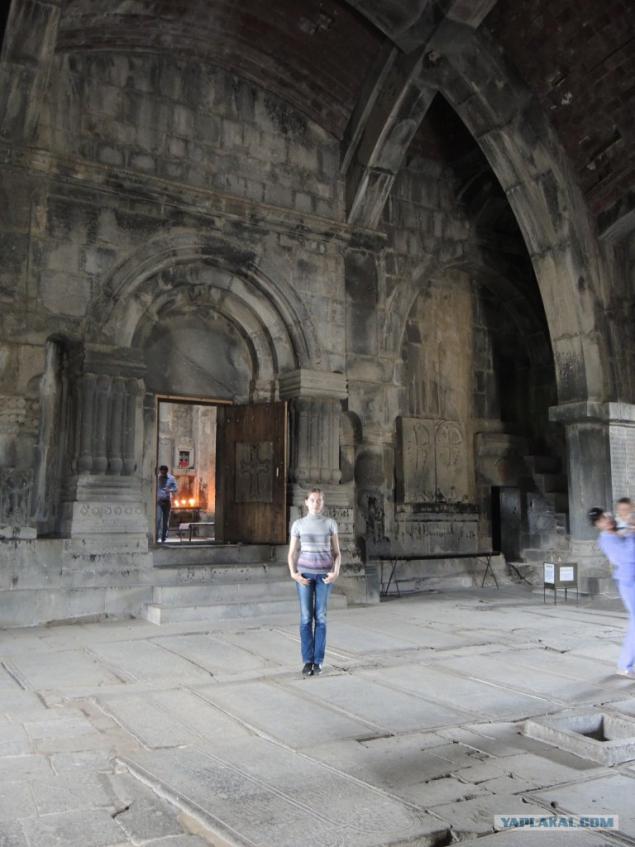
Haghpat listed as a UNESCO World Heritage, as well as other monastic complex, located nearby - Sanahin. Sanahin to Haghpat 500 years older, and he is also survived worse. The rest of the similarity between them is obvious - the same dark stone, the same gravestone in the floor space and trails. Only part of the building is fenced barrage tape due to the possible collapse of masonry. Here we are more impressed with the temple itself is not, and a woman selling souvenirs on the way to the monastery. It was obvious that they all live very poorly, and trade the same homemade aprons and oven gloves is almost the sole source of their existence. But when they saw us on the path that they did not try to sell us anything, and were worried that we would freeze Maxim, which we took with them to the monastery. They excitedly told how cold in the monastery, and offered free to take their towels or blankets, which they then traded to wrap Max. "On the way back you give, the money is not necessary," they said. As it was explained that this child from the Urals, and in Armenia it is, by definition, can not be frozen? And when we bought them a couple of tacks memory (about 100 rubles for our money), they looked at us as benefactors, and so much nazhelali the road! ..

Before the evening just went to Yerevan, without going anywhere else.
Source:
To the Pacific Ocean Bike - 2012
Eurotrip on a motorcycle or the seven seas - 2011
From traveling in 2012 we brought her son, so motoputeshestviyakh temporarily suspended.
And we went to the car initially in Stavropol and in Batumi.
And what happened - read below.
Author: Irinka
Background:
There were seven countries: Russia, Georgia, Armenia, Nagorno-Karabakh, Turkey, Azerbaijan, KazahstanVideli 2 Sea: Black and KaspiyskoeVideli Mount Ararat and Lake SevanProbeg: 10 000 kmPoezdka of this year has largely been for us "first." Firstly, the first time we went by car. And secondly, for the first time we are traveling with a child - our 4 month old son. Therefore, our luggage for the most part consisted of strollers, playpen, diapers, rattles, and other much-needed baby items.
Source

26.08.2013-29.08.2013
The first destination was the Stavropol, where he lived Maxim grandfather - Seryozhin dad.
From the first kilometers we realized that the speed of movement of the car with the baby is much lower than the two of us on a motorcycle. In addition, the first day we decided not to go through Simsk pass to avoid the wagons, and went through Beloretsk. As a result, the first day we were not even in Ufa.
From Ufa to Volgograd went already familiar from past road trip. And then, having passed Elista, in the afternoon of the 4th day of the roads were in Stavropol.

29.08.2013-01.09.2013
4 days rest in Stavropol - walked around the city, sightseeing, as well as a local botanical garden. However, in the middle of the holiday Sergei "word" intestinal infection and was hospitalized for five days. However, it is not particularly spoil the holiday, because on the second day he escaped and went on vacation.

Stavropol - a beautiful city, with the remains of the medieval castle in the center. The unusual climate here - very warm, but the wind blows constantly.

02.09.2013
At the beginning of the day slowly gathered, said goodbye to Sergei's dad and moved to the border with Georgia. Our way lay through the already familiar from previous visits land of Kabardino-Balkaria. By the evening reached Vladikavkaz, capital of North Ossetia. All day along the roads stretched endless fields planted with cereals, corn, apples, grapes and peaches.

The path also struck a significant difference between the cars registered in North and South Ossetia. Severoosetiny live strikingly poorer than the residents of South Ossetia, where neither car - the road jeep. Rumor has it that so hands separated the money allocated for the restoration of South Ossetia.
By nightfall we arrived in Vladikavkaz. With hotels there is the problem - there are some very expensive hotels with mediocre service. Finally, we choose a student residence, where for a small room with a toilet and cockroaches we had been 1,000 rubles.

But for dinner bought 2 of these, wonderfully delicious Ossetian pie - with meat and cheese. And where they still try, if not in the capital of North Ossetia?

03.09.2013
In the morning tour of Vladikavkaz. Very beautiful waterfront, magnificent monuments on the background of mountains and next to the magnificent cast park, lift and all traces of neglect and lack of tourists, which in good years must have been quite a few.

In the morning the weather we do not spoiled - low clouds, the sun was barely peeking out from behind the clouds, drizzling light rain, close to the border with Georgia transferred from the downpour. From Vladikavkaz to the border with Georgia at hand, though I had to go very slowly - a small streamers and slippery from the rain slows down the movement of the road.
The very easily passed the border - the baby in the car works wonders: is smiling staff who have passed almost without examination, after passing through passport control.

Georgia welcomed us with rain and cool weather. Near the border is Mount Kazbegi, which we unfortunately did not see because of the bad weather and low cloud. But it was possible to drive up close to a small temple of the first half of the millennium at the top of a small mountain at the foot of Kazbegi.
Along the way there are watchtowers, where residents hid impurity during the war and civil strife.

Then we waited for the Cross Pass and the Georgian Military Road. Despite the fact that we had been threatened with terrible stories about the pass, there is no cover on it, it did not seem to us so frightening. Yes and without coverage it was only a small area. On the descent was a difficult time for the baby, the road descended to 900 meters in height, for the first 11 kilometers. Such elevation changes, of course, let's not easy, and occasionally we had to make a stop, so that the pressure we and the child returned to normal.

The first major stop was planned at 70 km from Tbilisi, near the fortress Ananuri. This powerful fortress of 16-18 century, towering over the Aragvi, served as the main reference point for the then formidable rulers of this land.
Since the child was asleep, I visited the fortress, leaving him in the car with the windows ajar. The fortress itself is not large, and the main advantage of the castle - its preservation. The castle remained the full perimeter of the walls, two large towers and several smaller ones. Round Tower now stands without overlap, and at the square preserved floors and stairs. On the tower you can climb to the top.

Although the castle belongs to the 16-18 centuries, one of the towers dates back to the 13th century. From a historical point of view, the most interesting in Ananuri - it's Assumption Church. It was built in 1689 and is a rare case of the temple, postroennoo in the XVII century. These all over the country two or three. Temple classic, dome, on the west side - carved decorations: the cross and grapes. To the west of the Assumption is another temple, which is sometimes called Spassky, sometimes - Church of Our Lady. He's a little older. Time of construction is not known exactly - the late XVI or early XVII. Now it does not work inside is not renovated. Interestingly unless tombstone "mdivanbega Edisher."

Along the castle-fortress down a narrow lane leading to the reservoir, where you can find some more mysterious ruins. From their low perimeter walls there was nothing left. But the temple was - already in a dilapidated state. Now there is only a single cow grazing.
After strolling along the shore, went further in the direction of Tbilisi.

On the way we visited Jvari monastery of the 12th century. Jvari is one of the architectural masterpieces of perfection of architectural forms and is the first in Georgia World Heritage. Its special feature is that it seems to continue the mountain towering over her. From the very same monastery offers stunning views of the valley and the confluence of the rivers. Find the monastery is not difficult - as all the historical monuments of Georgia, lead to it special brown signs, which are found all the way from the road to the monument of architecture. The same indicators we later met in Armenia and Nagorno-Karabakh.

Examine Jvari, descended from the mountain, and came to Mtskheta - the old capital of Georgia, located just a few kilometers north of Tbilisi. Out of interest here for ourselves, we noted Svetitskhoveli - patriarchal cathedral church of the Georgian Orthodox Church, which for millennia was the main cathedral throughout Georgia. Listed among the World Heritage sites. It is now considered one of the spiritual symbols of modern Georgia.

In addition, in the historic part of the city there is a large number of shops with wine. However, taking the wine out there, we would not recommend - unreasonably high price tags based on tourists here combined with the very mediocre quality. Wine in Georgia is better to take away from the tourist areas.
Finally, twist a little Mtskheta, went to Tbilisi. The remaining few kilometers to the capital of Georgia, passed at the present motorway, which runs from Mtskheta, Gori, and continues to build toward Kutaisi.

Tbilisi itself is divided into two parts - the old Tbilisi historical buildings, and a new high-rise buildings with Tbilisi. As dusk, we, first of all, had to decide overnight. In the center of the historic part of the hotel to pick up is not a problem. However, many of them are located in the buildings of 17-18 century, is considered "new buildings". Accommodations can be found here for every taste - from an improvised hostel in a private house, where a few dozen chests you can pick up a clean spacious room with no doors and parking for the car, to the luxurious rooms at the hotel. After seeing a couple of options, we stopped at a hotel room in the center, which cost us $ 60 per night for three. At the same time, and the price includes breakfast and the room had air conditioning, shower, mini bar and TV and Internet.
Before nightfall we had a little walk around the city center, leaving sightseeing the next day. We had dinner here in the heart of the city, in one of the restaurants on the busy street. In the coming days, our diet composition of different barbecues, khachapuri, khinkali and other national dishes. It is worth noting the fact that the prices even in the very center of the city are very reasonable. So, dinner for two with barbecue cost us less than 50 GEL. However, if the institution receives dollars, it is better to take this opportunity to save money - because the amount to be paid in dollars when converted into rubles goes lower than that obtained when converted into rubles at the amount of GEL.
We went to sleep that day is closer to midnight.

04.09.2013
The whole day spent exploring the city, going to the stroller right after breakfast.
The windows of our rooms overlook the church of St. Virgin Mary, with the equestrian statue of David the Builder in the territory of the church. From the church clearly visible the historical part of the city.

Going down to the river, marched through the streets to the Sioni Cathedral of the same name, in which there are many ancient graves. We were lucky to get to the morning service.

We then briefly left the historic part of town, across the river on the new bridge in the park. Park called us with mixed feelings - in the heart of the historic city is located a new park with several seating areas, each of which is decorated in its own style. There contemporary design of glass and concrete, which looks quite strange on the background of the historic building. Everywhere the green, lots of flowers, neatly trimmed bushes, lawns and around the park paved walking paths. Just above the Park is the residence of the president.

Going round the park, on the same bridge back into the historical part of the city, and went to the basilica Anchiskhati. Anchiskhati, or the Church of the Nativity of the Virgin Mary, is the oldest of the surviving churches in Tbilisi, which dates back to the VI century. Unfortunately, it is very poorly preserved, but still operates.

Near Anchiskhati is a modern and very unusual building Rezo Gabriadze puppet theater. It is as if the collected set of large cubes on each other.

Here we left the old town, and along the fortress walls went on Rustaveli Avenue, which originates from the Freedom Square. In the center stands a column with the monument of St. George Zurab Tsereteli.

On the avenue, in addition to administrative buildings and even a church the early 20th century (Kashveti) is the National Museum of Georgia. Among other exhibits, our attention exposition dedicated to the occupation of Georgia by Soviet troops. However, there is not anything outstanding represented: wagon freight car, the doors of the bullpen, some photos and excerpts from personal letters to residents of that period. Strange looking messages that the oppressed Russian Georgians, led by the Georgian Stalin.

Turning off the avenue near the building of the Foreign Ministry, they climbed the mountain, which is located at the top of the TV tower and a children's park. Park is a funicular that connects the city center to the upper park on Mount Mtatsminda. Average stop half way to the park, located at the pantheon of public figures and poets, where we do not really gone.
Park on the mountain, as well as square, where we walked in the morning, very green and well maintained. A large number of attractions attract crowds of children, although for a walk with a stroller there is not very convenient because of the large number of steps and climbs and descents. By the time we got to the park, the air is warmed so that the child has been stripped to the diaper, and we ourselves have escaped the cold Borjomi. Therefore it was decided to arrange a siesta and return to the hotel.

Later in the afternoon went back to the city, this time we went to the fortress Narikala, which is located on another part of Mtatsminda. It led her cableway begins almost from our hotel. Tickets can be purchased in one or both ends. The first option is even better because of the fortress there is a short descent directly into the old part of town. However, we have learned about this later.

With wheelchair in the cabin of the cable car up, we had no difficulty. Here, at the top is a statue of Mother Georgia (Kartli Mother), erected in 1958. Near Narikala and Tbilisi Botanical Garden is located. On top of Narikala us caught in the rain, gradually developed into a hailstorm. Run up the stairs with a stroller in the rain - that still pleasure.
Back we went by cable car, and went to the old part of the city in search of the restaurant to have dinner. Continuing rain has given us dinner on the terrace of the restaurant (had to go to the premises of the restaurant) and we returned to the room to his knees wet.

05.09.2013
Despite the fact that in Georgia we had planned a lot more interesting, we decided to go to Armenia, as Georgia came the rain.
Crossed the border is relatively easy, however, had to pay a little more than 3,000 rubles. for various fees and insurance. As well as on the border with Georgia, the border guards are very friendly, and when he saw the child in the car passed inspection of the machine and put a mark in the passport are not asking us to leave the car.

Central Cathedral Guzii

Armenia itself impressed very poor and abandoned the country where ubiquitous destroyed the legacy of Soviet times - abandoned factories, dilapidated shops and factories. But at the same time, people are very friendly and open.

Almost immediately after crossing the border turned off the highway and drove a few kilometers to the first attractions in Armenia - Haghpat acting monastery in the same village Haghpat in northern Armenia, 10 km from the town of Alaverdi. The monastery is situated on a small plateau, the plateau surrounded by canyons. One gets the strange feeling: two villages in the Highlands one another down in the gorge. As the crow flies between several hundred meters, and to travel from one to the other, will have to drive a few tens of kilometers along a winding serpentine. When you go through the gorge, you see around the mountain, up the hill - it is expected that at the top we will see the next valley and the view for kilometers around, but very surprised when the top is a city with a 10-storied buildings and in general it is not the top, and plain.

Himself Haghpat was founded at the end of the 1st millennium. The complex is very well preserved. We visited several churches, refectory, porch and tomb. Strange and a little frightening feature is the custom to bury the dead right in the floor of the church and along the walls of the monastery, which is why often the path between the buildings and in the premises of passes on ancient tombstones.

Haghpat listed as a UNESCO World Heritage, as well as other monastic complex, located nearby - Sanahin. Sanahin to Haghpat 500 years older, and he is also survived worse. The rest of the similarity between them is obvious - the same dark stone, the same gravestone in the floor space and trails. Only part of the building is fenced barrage tape due to the possible collapse of masonry. Here we are more impressed with the temple itself is not, and a woman selling souvenirs on the way to the monastery. It was obvious that they all live very poorly, and trade the same homemade aprons and oven gloves is almost the sole source of their existence. But when they saw us on the path that they did not try to sell us anything, and were worried that we would freeze Maxim, which we took with them to the monastery. They excitedly told how cold in the monastery, and offered free to take their towels or blankets, which they then traded to wrap Max. "On the way back you give, the money is not necessary," they said. As it was explained that this child from the Urals, and in Armenia it is, by definition, can not be frozen? And when we bought them a couple of tacks memory (about 100 rubles for our money), they looked at us as benefactors, and so much nazhelali the road! ..

Before the evening just went to Yerevan, without going anywhere else.
Source:

